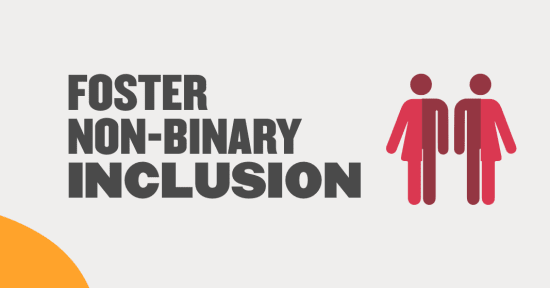Promoting non-binary inclusion and understanding benefits both employees and employers.
An inclusive workplace will attract and keep high-quality candidates who might otherwise not be hired or promoted and attract customers who are increasingly choosing to support inclusive businesses. Most importantly, implementing sensitivity practices in the workplace can combat ignorance and aggression, moving not just businesses but society as a whole towards fully accepting non-binary and gender non-conforming individuals.
Here are 10 ways your company can foster non-binary inclusion:
1. Protect gender identity and gender expression
By including non-binary protections in your company’s anti-harassment and non-discrimination policy, you will signal a culture of inclusion and support. Make clear during recruitment and onboarding processes that gender expression (ie. attire or hairstyle) and gender identity are protected and any infringements will be strictly responded to. There should be zero tolerance for intolerance in the workplace.
2. Permit gender expression
While many offices have dress codes, these should not exclude non-binary employees from presenting as their gender. Modify uniform clauses and apply them consistently to avoid perpetuating gender stereotypes and alienate non-binary team members. Another important way to protect gender expression is to give employees the ability to self-identify on HR platforms and systems. HR managers should include an inclusive list of pronouns and genders for administrative systems and forms. Field menus with drop-down arrows allowing the addition of pronouns and genders in coordination with employees’ self-identification and gender expression, if set up correctly, will foster inclusion at the systems level. And of course, with most companies transitioning into work-from-home structures, it would seem archaic not to foster inclusion using accurate and viable gender expression.

3. Protect employee privacy
During the hiring process, recruiting and hiring personnel may become aware that a candidate has transitioned. Background checks, references, social security, and other documents will contain pre-transition information including name and sex. While it is self-evident that this should not impact the individual’s chances of securing the position they are applying for, discretion is also important. Outing candidates or employees against their wishes is hurtful, insensitive, and inappropriate.
4. Support transitioning employees
It is important to delineate clear guidelines for transitioning employees and for their supervisors and colleagues. These protocols may include allowances for working remotely, paid leave, a hygienic and private room for administering hormonal injections, and other accommodations to ensure that transitioning employees are not excluded.
5. Implement comprehensive sensitivity training
Lack of understanding and knowledge is a major contributing factor to the exclusion and mistreatment of non-binary individuals in the workplace. It is vital to engage staff and implement comprehensive sensitivity and anti-harassment training – from senior management to lay staff. Empower all employees to become allies and educate them to advocate for non-binary inclusion, both within the office setting and without. These initiatives may be part of pre-existing diversity and EEO compliance training or may be implemented separately. One suggestion is to invite non-binary community advocates or representatives to address management and employees.
6. Facilitate documentation changes and options
Transitioning is hard enough as it is, but bureaucratic and documentation foot-dragging can make the journey even harder. It may take months for a legal name change or gender change to be made official. Furthermore, many government forms and documents only include two genders – even the EEOC doesn’t include a third or other categories for gender on employer reporting forms. While many departments accommodate moving from male to female on documentation, there is no category available for those who do not identify as male or female. For non-binary individuals this means being forced into checking a box that doesn’t actually correspond to their real gender.
Leaving gender fields blank or giving the option to add additional gender or pronoun categories in both paper and online HR forms and platforms is another policy to promote the inclusion of non-binary individuals in the workplace. By offering applicants and employees the opportunity to designate their gender beyond the binary, your company is signaling a culture of acceptance and support.
7. Establish bathroom and locker room access
One of the most prominent topics in the conversation around non-binary inclusion in the workplace centers on the sex-segregated bathrooms. Forcing employees to use facilities that do not correspond with their gender is harmful and discriminatory, and recently the expectation that trans employees should have access to bathrooms that correspond with their presentation regardless of the stage of transition is increasingly expected. However, for non-binary individuals, gendered bathrooms are still problematic. Some options for overcoming this hurdle are:
- Single-occupant, gender-neutral bathrooms.
- Multiple-occupant, gender-neutral bathrooms with private, single-occupant stalls.
8. Inclusive health insurance policies
Legally, doctors, hospitals and insurance companies are not permitted to discriminate against trans or non-binary people in the provision of health care. Health plans cannot exclude transition-related care and every individual must be treated according to their gender, without discrimination. Companies do not need to stop at the basic legal requirement – fully covering gender confirmation surgery, mental health counseling, prescription drug or hormone therapy, and other treatments commonly utilized by trans and non-binary individuals is an important step towards inclusion. Short-term disability coverage following gender confirmation surgery should also be included in company health coverage.
Recommended For Further Reading
9. Actively recruit individuals from protected communities
The discrimination and exclusion faced by non-binary individuals mean that it is necessary to take proactive measures to engage with potential employees that identify as non-binary. Evaluate your procurement process to ensure inclusion and publicize your socially responsible policies to attract highly-qualified candidates who are either non-binary or are seeking a more inclusive workplace.
This will also likely attract customers who increasingly choose to support inclusive businesses. The 2017 Harris Poll for GLAAD found that nearly 70% of Americans would switch to a brand that is LGBT-friendly and most would actively avoid businesses that are less inclusive. As more consumers are stepping up to champion LGBT and non-binary rights in the workplace, there are utilitarian benefits to doing the right thing. Recruit better talent, keep employees happier and more productive, and build brand loyalty with inclusive workplace practices and policies.
One vital way to promote inclusion is by leveraging workforce analytics to better understand and identify organization-wide needs. Tapping into essential data can help you expand diversity hiring and programs, communicate with leaders, and ensure that your company practices are unbiased.
10. Encourage neutral of preferred pronoun use
One of the most important ways to include non-binary employees is to adopt their chosen pronouns. By and large, binary pronouns like he/him or she/her are just how most people speak. However, for non-binary individuals, these two categories are insufficient. While some trans men and women prefer gendered pronouns, some trans people and many non-binary people prefer neutral pronouns such as they/them, it/its or ze/hir. Not making assumptions about a person’s correct pronouns is vital to creating an inclusive workplace and should likewise be included in any sensitivity training.
Another way to normalize the use of preferred gender pronouns and encourage greater sensitivity is to incorporate neutral language and greetings instead of gendered expressions like “guys” or “ladies”.
Finally, offering the option of adding pronouns on HR forms, platforms, and systems will ensure that employees are given the opportunity to express their pronoun preferences, fostering greater inclusion and avoiding uncomfortable misgendering or mistaken pronoun use.
A lack of understanding and knowledge about the unique experiences of trans and non-binary individuals is one of the main barriers to inclusion in the workplace. Although every individual gender identity journey is different, there are common practices and processes that employers can implement towards educating and facilitating acceptance. These systems are not about legal compliance, they are about creating an environment where employees can flourish regardless of their gender identity.
To learn more about how your organization can promote the inclusion of non-binary personnel, please download our HR Guide to Non-Binary Inclusion.
You too can participate in International Transgender Day of Visibility, by making a difference where it really counts. If you wish to contribute to the community during this challenging time in human history, we recommend sending donations to the LGBTQ funding resources for COVID-19 or the COVID-19 Mutual Aid Fund for LGBTQI+ BIPOC Folks.

From Stephanie Stevens
Stephanie is Content Marketer at HiBob. She has a background in Clinical Psychology and Crisis Management, and enjoys abstract painting and watching horror films in her spare time. She believes that people can connect with themselves, their peers, and the world around them through creative writing, helping them foster a deeper sense of self and their life goals in the process.

